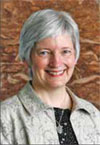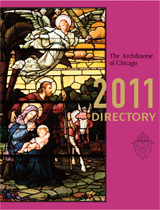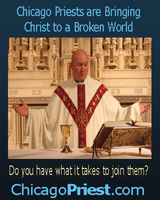Consecrated virgins witness the spousal love of Christ

A regular feature of The Catholic New World, The InterVIEW is an in-depth conversation with a person whose words, actions or ideas affect today's Catholic. It may be affirming of faith or confrontational. But it will always be stimulating.
Judith Stegman, president of the the United States Association of Consecrated Virgins, drove from her home in Lansing, Mich., to Chicago for the June 28 consecration of Diane Zervos at St. Thomas More Church. Zervos became one of a half-dozen consecrated virgins in the archdiocese in a ceremony that bears some resemblance to a wedding.
Stegman, 52, was one of many guests, welcoming Zervos to the way of life she embraced in 1993. There are about 200 members of the Order of Virgins living in the United States; Stegman, a CPA by profession, spoke with assistant editor Michelle Martin about what it means to be a “bride of Christ.”
Catholic New World: Is the vocation of a consecrated virgin living in the world a new thing?
 Judith Stegman: This is the earliest form of consecrated life that there is in the church. It dates back to apostolic times. The very first women that responded to Jesus’ call that someone live single for the sake of the kingdom of God would have been considered consecrated virgins. They lived with their families, as individuals living within the society, and they were following Jesus that way. The church began to develop a consecration rite that was similar to a wedding rite. That rite was developed for the women who were living in the world.
Judith Stegman: This is the earliest form of consecrated life that there is in the church. It dates back to apostolic times. The very first women that responded to Jesus’ call that someone live single for the sake of the kingdom of God would have been considered consecrated virgins. They lived with their families, as individuals living within the society, and they were following Jesus that way. The church began to develop a consecration rite that was similar to a wedding rite. That rite was developed for the women who were living in the world.
Over the centuries, women started to band together, to develop a particular spirituality in religious orders. That became the norm for a woman to live out a call to a life of virginity for Christ.
It was around the 9th century that the consecration rite for a woman living in the world stopped being used, and the only way to live out a bridal relationship with Christ was within a religious community.
It was around the turn of the 20th century that women started petitioning the Vatican for the consecration of virgins to be opened again to women living in the world. It was the fruit of the Second Vatican Council that the rite itself was restored in 1970. So in some sense, it’s the newest form of consecrated life; in some sense it’s the most ancient form.
CNW: What role do consecrated virgins play?
Stegman: The consecrated virgin receives the title that the church herself has, that is, the Bride of Christ. She is set apart in the church to live out that bridal relationship with Christ and to be a witness in her own person of the life that all of us will live for eternity in relationship with Christ. She is also a sign of the intimacy that a person can expect in his or her relationship with Christ. Jesus presents himself as bridegroom of the church, and it’s a very real relationship. He gives himself in the Eucharist. The consecrated virgin is a person who lives out what it means to be the bride of Christ; she lives in intimacy with him, in union with him.
CNW: On a practical level, what do consecrated virgins do?
Stegman: A consecrated virgin is committed to prayer, to pray the Liturgy of the Hours, as any person in consecrated life would. She’s living as a bride of Christ, and it’s much more about who we are than about what we do. Often, I’ll say it’s the same way a married person, by virtue of being married, isn’t doing anything differently. It’s about her relationships; it’s about who she is. It’s about who a consecrated virgin is too. It’s about her relationships, her relationship with Christ, her relationship with others. The consecration itself makes her virginity spiritually fruitful. ... She has a great love for the church. She will take on roles of service that the bishop might ask her to do. But none are really intrinsic to being a consecrated virgin. She will keep her own secular work and be the witness to the love of Christ as bridegroom right in the midst of her daily relationships.
CNW: What are some of the primary misunderstandings?
Stegman: Misunderstandings arise often because people have only been familiar with the religious life. We are authentically not called to live in community. We live individually within our dioceses. We do not live in the same way, or have a vow of poverty. We are not called sister. We don’t wear a habit. Those things are proper to one who is removed from the world, as those in religious communities are, but not proper to an individual who is living her life fully immersed in the world. She’s in the world, but not of the world.
CNW: How did you know that you were called to this life?
Stegman: I remember hearing a talk once in college — it was at a Newman Center — and the speaker said, “Some of you are called to give your whole, what John Paul calls the gift of self that you are going to give in marriage, not to a human husband but you are called to give it to Christ. Some of you are called to marriage to a human husband. Think in terms of who it is you are going to give your love to, and what Christ has put deep into your heart.” I remember thinking, “Oh, that’s who I am. That’s what’s been stirring in my heart all this time.”
It was a number of years that I was living and just thinking, “What do you have for me, Lord?” when someone handed me an article that was about the restoration of the rite of consecration. I read it and immediately knew this was my vocation.
CNW: What is it in your vocation that gives you joy?
Stegman: It’s unbelievable to go through life with the knowledge that Jesus is my spouse, and is there in as close a reality as any human spouse could be. In so many different things, where I’ve had a need and turned and said, “O, Lord, if I was married, this would be taken care of,” and something happened to take are if it, a practical need. A great joy in the confidence I have come to have in him and his way of fulfilling every need I have, internal, external.
He is truly my joy and my hope and my everything. It’s a good life.




